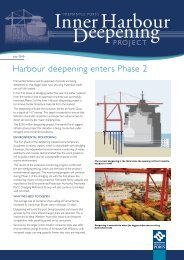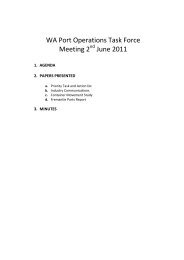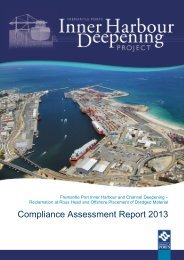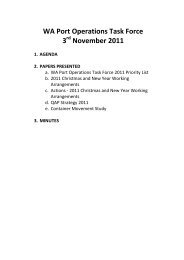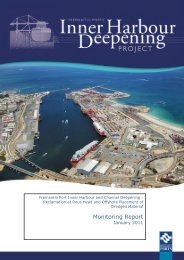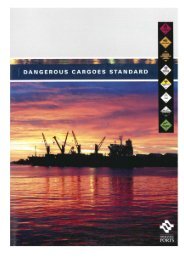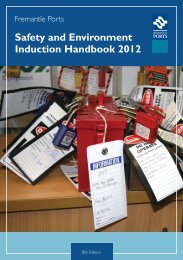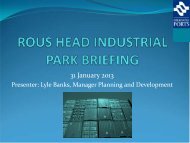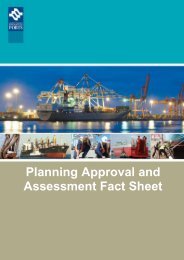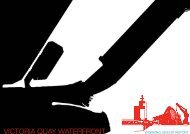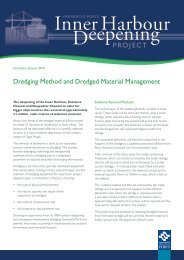guidelines - Fremantle Ports
guidelines - Fremantle Ports
guidelines - Fremantle Ports
You also want an ePaper? Increase the reach of your titles
YUMPU automatically turns print PDFs into web optimized ePapers that Google loves.
CONSTRUCTION<br />
ENVIRONMENTAL MANAGEMENT PLAN (CEMP)<br />
GUIDELINES
FREMANTLE PORTS<br />
CONSTRUCTION<br />
ENVIRONMENTAL MANAGEMENT PLAN (CEMP)<br />
GUIDELINES<br />
AUGUST 2011<br />
TRIM - 443525<br />
1
CONTENTS<br />
CONSTRUCTION ....................................................................................................... 1<br />
ENVIRONMENTAL MANAGEMENT PLAN (CEMP) ......................................... 1<br />
GUIDELINES ............................................................................................................... 1<br />
1 INTRODUCTION ................................................................................................... 3<br />
1.1 PURPOSE ................................................................................................ 3<br />
2 LEGISLATIVE FRAMEWORK ................................................................................ 4<br />
3 PREPARATION FOR CEMP DEVELOPMENT ........................................................ 5<br />
3.1 ENVIRONMENTAL RISK/SITE ASSESSMENT ........................................... 5<br />
4 CONTENTS OF THE CEMP ................................................................................... 6<br />
5 REFERENCES/KEY DOCUMENTS ........................................................................ 9<br />
APPENDICES<br />
Attachment 1: List of Potential Construction Environmental Aspects<br />
Attachment 2: Example Presentation of Environmental Aspects for the Project.<br />
2
1 INTRODUCTION<br />
<strong>Fremantle</strong> <strong>Ports</strong> is committed to facilitating trade in a sustainable way and maintaining the<br />
highest environmental standards. These <strong>guidelines</strong> form one component of the overall<br />
environmental management strategy and aim to provide tenants and contractors with guidance<br />
for the development of their Construction Environmental Management Plan (CEMP).<br />
A CEMP is a practical plan of management measures which are designed to minimise<br />
environmental impact from the construction phase of a development. Further, it provides a<br />
framework within which the measures will be implemented throughout the project.<br />
A CEMP provides project-specific management measures and is a dynamic document which<br />
should be reviewed if activities or conditions onsite change that may influence management<br />
measures. Further, an audit schedule should be implemented against the details of the CEMP.<br />
In accordance with the requirements of <strong>Fremantle</strong> <strong>Ports</strong> Development Guidelines, construction<br />
projects within the Port may require a CEMP to be prepared. This requirement is separate to the<br />
Operational Environmental Management Plan (EMP) requirement that outlines environmental<br />
management measures for the operational phase of a facility.<br />
The size, complexity and location of the project will guide the development of the CEMP. For<br />
example, a project undertaken on a hardstand area is likely to have a relatively simple CEMP<br />
when compared to a large project undertaken adjacent to, or over, Port Waters. The<br />
development of the management measures should be based on a risk assessment approach.<br />
1.1 Purpose<br />
These <strong>guidelines</strong> provide a framework for the development of a CEMP.<br />
Ultimately, it is the contractor’s responsibility to ensure that appropriate actions are documented<br />
and implemented to mitigate potential environmental impacts that may be associated with the<br />
project.<br />
3
2 LEGISLATIVE FRAMEWORK<br />
Environmental issues at <strong>Fremantle</strong> Port are administered principally by the following State<br />
legislation:<br />
Port Authorities Act 1999 (the Act) and Regulations (2001)<br />
Environmental Protection Act 1986 and Regulations (1987)<br />
Contaminated Sites Act 2003 and Regulations (2006)<br />
Pollution of Waters by Oil and Noxious Substances Act 1987 and Regulations (1993)<br />
Mining Act 1978 and Regulations (1981)<br />
Heritage of Western Australia Act 1990<br />
Whilst environmental protection is principally administered by the above legislation,<br />
Commonwealth laws may be applicable in certain circumstances. These include:<br />
Environmental Protection and Biodiversity Conservation Act 1999<br />
Australian Heritage Council Act 2003<br />
National Environment Protection Council Act 1994<br />
Other State requirements that may apply to environmental management include but are not<br />
limited to:<br />
Department of Environment and Conservation (DEC) Contaminated Sites Management<br />
Series<br />
Western Australian Planning Commission (WAPC) Planning Bulletin No. 64 - Acid<br />
Sulphate Soils<br />
Department of Environment and Conservation (DEC) Acid Sulphate Soils Guideline<br />
Series<br />
Environmental Protection (Controlled Waste) Regulations 2004<br />
Dangerous Goods Safety Act 2004 and Regulations 2007<br />
DEC Draft - A guideline for the development and implementation of a dust management<br />
program<br />
DEC Water Quality Protection Note - Dewatering of Soil<br />
Project specific approval conditions (where applicable).<br />
Note - The contractor must ensure that all activities undertaken comply with the relevant<br />
legislation, government <strong>guidelines</strong> and approvals.<br />
4
3 PREPARATION FOR CEMP DEVELOPMENT<br />
Prior to the development of the CEMP, a number of steps should be undertaken to ensure<br />
the environmental aspects and risks associated with the project are identified. This is a critical<br />
component of the process and will ultimately drive the management measures that are<br />
implemented.<br />
3.1 Environmental Risk/Site Assessment<br />
The contractor should undertake an environmental risk assessment to identify potential<br />
environmental impacts of the project. This assessment may be undertaken in a number of ways<br />
including the formal risk assessment process or a comprehensive site assessment.<br />
The CEMP may not require all components of these <strong>guidelines</strong> depending upon the outcomes<br />
of the assessment.<br />
The assessment should give consideration to each work activity to be undertaken and the<br />
potential for them to impact on the environment. The contractor should provide details on the<br />
rating system used to determine the level of consequence and likelihood.<br />
<strong>Fremantle</strong> <strong>Ports</strong> may identify additional risks at any time prior to or during construction, which<br />
will be communicated to the contractor to be addressed in the CEMP.<br />
5
4 CONTENTS OF THE CEMP<br />
Table 1 provides an outline of the structure and content that would typically make up a CEMP.<br />
Generally, the content of the CEMP document should be clear and concise and should only contain relevant<br />
information for environmental management aspects of that project.<br />
Table 1 Expected structure and content of a CEMP<br />
CEMP RECOMMENDED CONTENT<br />
COMMENTS<br />
Organisational Procedures<br />
Environmental Policy - provide a copy of the<br />
Environmental Policy and a commitment to<br />
sustainability<br />
Regulatory Framework - demonstrate an<br />
understanding of the regulatory framework at<br />
<strong>Fremantle</strong> <strong>Ports</strong>.<br />
Refer to applicable State and Commonwealth<br />
legislation.<br />
Provide details of consultation and liaison with<br />
government agencies if applicable.<br />
Copies of relevant regulatory approvals, licences<br />
and permits should be provided if applicable.<br />
Key Staff - The contractor’s organisational<br />
structure should be provided including<br />
responsibility levels for key staff associated<br />
with the project and contact numbers.<br />
This typically includes as a minimum:<br />
• Contractor’s representative (such as<br />
project manager/site engineer)<br />
• Site environmental contact<br />
• Site Foreman/Superintendent<br />
• <strong>Fremantle</strong> <strong>Ports</strong>’ project manager (if<br />
applicable)<br />
• Emergency Contact<br />
Site Induction and Training - The site induction<br />
process and the integration of CEMP<br />
requirements within this should be outlined.<br />
Details of any other mechanisms that are utilised<br />
for staff training, such as toolbox talks, Job<br />
Analyses (JA) forms or prestart meetings should<br />
be outlined.
CEMP RECOMMENDED CONTENT<br />
COMMENTS<br />
Incident Management System - The CEMP<br />
should include details of the contractor’s<br />
incident management system, including<br />
procedures for reporting, corrective actions<br />
and record keeping.<br />
The CEMP should include procedures for<br />
reporting incidents to <strong>Fremantle</strong> <strong>Ports</strong>, including<br />
timeframes.<br />
Complaint Management System - The CEMP<br />
should include details of the contractor’s<br />
complaint management system, including<br />
procedures for reporting, corrective actions<br />
and recording.<br />
The CEMP should include procedures for<br />
reporting complaints to <strong>Fremantle</strong> <strong>Ports</strong>, including<br />
timeframes.<br />
CEMP Audit and Review Process - Details of<br />
the audit and review process of the CEMP<br />
should be outlined.<br />
The contractor will need to undertake periodic<br />
compliance audits of the CEMP. The frequency<br />
and extent of the audits will depend on the<br />
characteristics of the project. It may range from a<br />
weekly checklist, to a complete audit with<br />
meetings and a report produced.<br />
The CEMP also needs to be reviewed to ensure it<br />
remains up to date and relevant. The CEMP<br />
should detail the process of how changes in site<br />
activities or the project are incorporated into the<br />
CEMP.<br />
Scheduled Reporting - The CEMP should<br />
provide an outline of any periodic reporting<br />
components.<br />
The frequency and detail of reporting will depend<br />
upon the characteristics of the project. For<br />
example, small projects may only need a single<br />
page letter report whereas larger projects may<br />
require monthly reporting on aspects such as;<br />
Results of inspections and monitoring<br />
Performance against targets<br />
Summary of incidents and complaints<br />
Corrective actions implemented<br />
7
CEMP RECOMMENDED CONTENT<br />
COMMENTS<br />
Project Details<br />
Project Outline - provide an outline of the<br />
project.<br />
Details would typically include:<br />
Proposed timing/duration of works<br />
Description of work methods<br />
Types of plant/equipment to be used on<br />
site<br />
Proposed site layout in figure format.<br />
Environmental Aspects<br />
This section should provide detail on all<br />
identified environmental aspects and how they<br />
will be managed to minimise environmental<br />
impacts.<br />
Typically information provided will include<br />
• Actions or mitigation strategies that will<br />
be implemented<br />
• Performance indicators<br />
• Any monitoring and reporting<br />
processes<br />
• Corrective actions to be undertaken<br />
should the performance requirements<br />
not be met<br />
• Responsibilities<br />
Attachment 1 provides a list of construction<br />
environmental aspects that may require<br />
consideration.<br />
Attachment 2 provides an example of how a<br />
contractor may choose to present elements for<br />
this component of the CEMP.<br />
In some circumstances it may be necessary to<br />
provide specific Work Method Statements (or<br />
similar).<br />
Relationship with other Site Plans<br />
This section should outline the relationship<br />
between the CEMP and other documentation<br />
or frameworks for the site.<br />
Where appropriate, supporting documents can be<br />
appended to the CEMP. Reference to other plans<br />
provided under the <strong>Fremantle</strong> <strong>Ports</strong> development<br />
framework such as an Operational Environmental<br />
Management Plan (EMP), Emergency Response<br />
Plan, Traffic Management Plan, Landscaping<br />
Plan or Stormwater Management Plan may also<br />
be useful.<br />
Whilst the CEMP needs to be project and site<br />
specific, it is acceptable to integrate the CEMP<br />
within other site plans and documentation such as<br />
Safety Management Plans. HSEQ plans are<br />
common for smaller projects.<br />
8
5 REFERENCES/KEY DOCUMENTS<br />
<strong>Fremantle</strong> <strong>Ports</strong><br />
Port Authority Act 1999 and Regulations<br />
<strong>Fremantle</strong> <strong>Ports</strong> Development Guidelines, 2010.<br />
<strong>Fremantle</strong> <strong>Ports</strong> Operational Environmental Management Plan (EMP) Guidelines. 2011<br />
www.fremantleports.com.au - this website contains many critical documents and links for<br />
planning and development at <strong>Fremantle</strong> <strong>Ports</strong>.<br />
Department of Environment and Conservation<br />
Environmental Protection Act 1986 and Regulations<br />
Contaminated Sites Act 2003 and Regulations<br />
Environmental Protection (Controlled Waste) Regulations 2004<br />
Contaminated Sites Management Series, including:<br />
Development of Sampling and Analyses Programs<br />
Reporting on Site Assessments<br />
Assessment Levels for Soils Sediment and Water<br />
Acid Sulphate Soils Guideline Series, including:<br />
Identification and Investigation of Acid Sulphate Soils and Acidic Landscapes 2009.<br />
Draft Treatment and Management of Soils and Water in Acid Sulphate Soil Landscapes<br />
2009.<br />
A Guideline for the Development and Implementation of a Dust Management Program 2008<br />
Water and Rivers Commission. Water Quality Protection Note - Dewatering of Soil 2003.<br />
www.dec.wa.gov.au - Department of Environment and Conservation website which contains<br />
links to Acid Sulphate Soils, dewatering, dust management and Contaminated Sites<br />
Management Series <strong>guidelines</strong>.<br />
Western Australian Planning Commission<br />
Planning Bulletin No. 64/2009 - Acid Sulphate Soils<br />
Department of Mines and Petroleum<br />
Dangerous Goods Safety Act 2004 and Regulations 2007<br />
Department of Environment Water Heritage and the Arts<br />
Environmental Protection and Biodiversity Conservation Act 1999<br />
Australian Heritage Council Act 2003<br />
National Environment Protection Council Act 1994<br />
9
Attachment 1<br />
Potential Construction Environmental Aspects<br />
Note this list is not exhaustive and is provided for guidance only.<br />
(a)<br />
(b)<br />
(c)<br />
(d)<br />
(e)<br />
(f)<br />
(g)<br />
(h)<br />
(i)<br />
(j)<br />
(k)<br />
(l)<br />
(m)<br />
(n)<br />
(o)<br />
(p)<br />
(q)<br />
Soil Erosion and Sediment Control<br />
Management of Acid Sulphate Soils<br />
Flora and Fauna<br />
Contaminated Sites<br />
Cultural Heritage<br />
Air Quality<br />
General Waste Management<br />
Hazardous Waste Management<br />
Water Quality<br />
Dewatering<br />
Storage and Handling of Chemicals and Hazardous Materials<br />
Refuelling<br />
Construction Noise<br />
Light<br />
Vibration<br />
Spill Management<br />
Housekeeping
Attachment 2<br />
Example of how the contractor may choose to present the detailed environmental aspects for the project.<br />
Note this is not exhaustive and is provided as an example for information only.<br />
Element<br />
Objective/Target<br />
Actions<br />
Performance<br />
Indicators<br />
Monitoring<br />
Reporting<br />
Corrective Action<br />
Term<br />
Responsibility<br />
Waste Management - General Wastes<br />
To ensure that general refuse produced during construction is collected, retained and transferred to an<br />
appropriate facility for disposal or recycling.<br />
To minimise waste to landfill and maximise recycling.<br />
Supply of appropriate type and number of clearly labelled collection bins.<br />
Material placed in bins to be as compacted as possible to reduce space requirements.<br />
Bins to be secured at all times to prevent material loss.<br />
Construction waste segregated, where practical, for recycling.<br />
Inappropriate storage or loss of general waste.<br />
Volume of waste recycled as a percentage of total waste volume.<br />
Weekly visual assessment of collection points.<br />
Volume of waste to landfill and recycled to be recorded.<br />
Reporting of inappropriate storage loss or loss of waste to the Foreman.<br />
Quantity of waste disposed of and recycled to be provided in the monthly report to <strong>Fremantle</strong> <strong>Ports</strong>.<br />
Review procedure causing material loss and rectify immediately.<br />
If necessary, order additional/alternative waste receptacles<br />
At all times during construction.<br />
Site Foreman.



